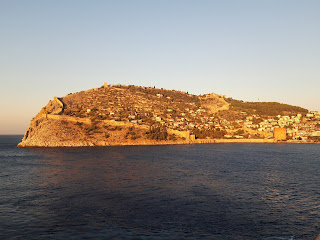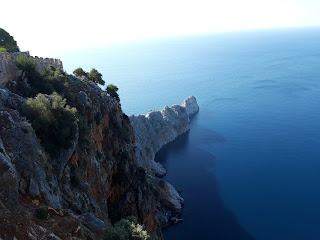More of last years holiday snaps of historical interest. After Cyprus, the next stop was southern Turkey, a day each in Alanya and Antalya. I've rolled them into one.
First stop was Alanya, an old Seljuk Turk stronghold and now a heaving tourist resort, although more popular with Germans and Russians than Brits, who tend to go further west.
We sailed into harbour at dawn. The entire headland is a Seljuk fortress (you can just make out the walls).
Sunrise in the Eastern Med. Fabulous. It was also baking hot here.
The sea was like a bath, wish we'd brought our swimming stuff ashore.
This is the reverse side of the fortress.
The Alanya Healing Cave. This has been used for centuries as a health cure. It has a humidity of around 99% and is very good for asthma.
There were cable cars near the Healing Cave up to the top of the mountain.
We went up by bus. Our ship moored in the harbour.
The walls at the top very well preserved, as was the old Byzantine church.
Stone cannon balls!
View from the fortress back over the city, some outworks visible below. The mountains go right along the coast here, which is partly why it was so hot and arid.
This is the top of the cliff we saw earlier. If slaves could throw a rock from the battlements into the sea from here, they were freed. It was virtually impossible as there as a bit of a slope at the top of the cliff.
Some surviving frescos inside the palace.
A model of the fort.
Pompey the Great found his way here.
The Red Tower was right down by the harbour and formed the corner of two of the curtain walls.
It is quite large!
Some of the curtain wall going back up the headland.
Battlements at the top of the Red Tower.
Various unpleasant Seljuk weaponry.
Original Seljuk artwork. The Asiatic influence is very obvious.
Mustapha Kemal Ataturk.
More stone cannon balls (or catapult ammo).
And even more ammunition.
The vaulting inside the tower was fabulous, but curiously was brick built rather than stone.
The courtyard at the top of the tower.
Reproduction catapult.
The bay had a number of 'Pirate Ships' providing tourist trips. I wouldn't fancy one of these in rough weather.
The archways are the old naval dockyard for constructing and mooring galleys etc. The Red Tower protects them.
Slightly closer view of the dockyard with a 'pirate ship' in front for scale.
That was surprisingly delightful and very interesting. A part of the world I know little about, I'd not really appreciated its historical significance.
That evening we sailed the 150 miles west to Antalya.
Antalya is a much bigger place, but also a huge tourist resort now. There are some lovely old buildings in the old town though.
An interesting mix of architectures.
A very old building. Hadrians Gate!
Roman cart tracks in the stone. Stuff like this just blows me away. This is why modern roads (and cars) are the width they are. What did the Romans ever do for us?
The gate from the other side.
The old town was a maze of narrow streets.
More Roman remains, scripted in Greek.
A lot of the place had been gentrified, but some of the buildings were still quite old.
This is the original, ancient harbour. Very well sheltered and protected.
But easy access to the (stunning) bay.
There was a very pleasant park next to the harbour.
More of the old buildings.
Inside the old town walls around the harbour.
On the inner side they had a number of 'divan rooms' set into the walls.
This is one of the oldest minarets, and is Seljuk (brick built) rather the the later Ottoman style.
And a Byzantine church.
And a rather grand Ottoman Mosque.
Next stop was the Antalya Archaeological Museum.
Early Bronze Age pottery, 5000(!) BC.
And some rather more recent Greek pottery. Another shield design to paint.
There were some rather grand Imperial Roman statues. This is Hadrian.
And Faustina.
As ever, the script on the Roman statues was in Greek.
Not an Emperor but a God. Apollo in this case.
Emperor Trajan.
There was a nice animated show of Hercules adventures. Here he is fighting the Hydra.
The real highlight of the museum was the collection of Roman sarcophagi. Just amazing (I think they were mainly from Perge).
I was particularly taken with this one as unlike European sarcophagi, the occupants are sculpted as sitting up.
Grave robbers had broken into most of them.
More Gods. Nemesis this time.
Silverware.
And some nice mosaics.
A couple of Hoplites playing a game. Hoplites were gamers too.
On a stone gaming table just like this one! Hard to see in the photo but there are various grids inscribed on the table to play a number of games.
Amphorae retrieved from wrecks around the coast.
And silver hoards.
Father Christmas a.k.a. St Nicholas.
Icons of various types.
A fresco/bas relief of a Hippogriff.
I found this burial marker rather moving. It reminded me of playing Johns 'Cursus Honorum' game of Roman career advancement.
Blazing sunshine outside, still unseasonably hot for November.
Sunset over the mountains by the coast.
That was really enjoyable and I'd have happily spent a lot more time there. I was just amazed at how much historical stuff there was and I reckon Eastern Turkey is worth a two week tour on its own. Somewhere I hope to get back to.
















































.jpg)
































No comments:
Post a Comment